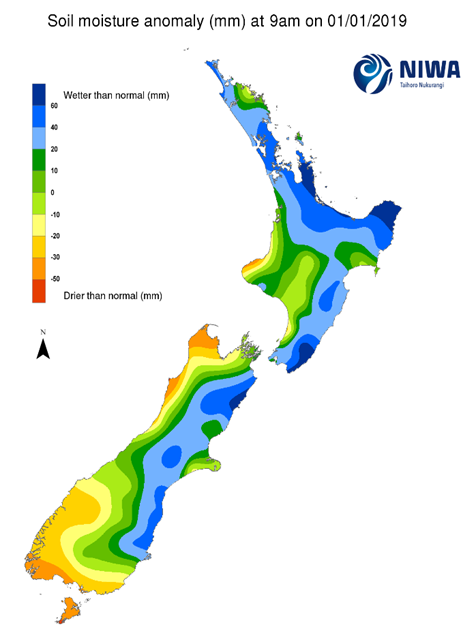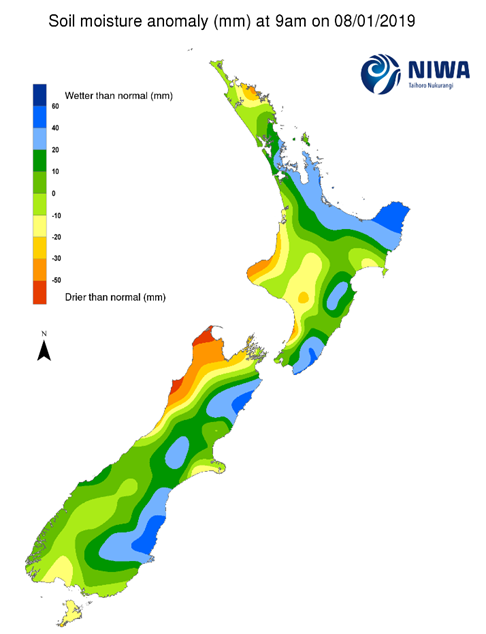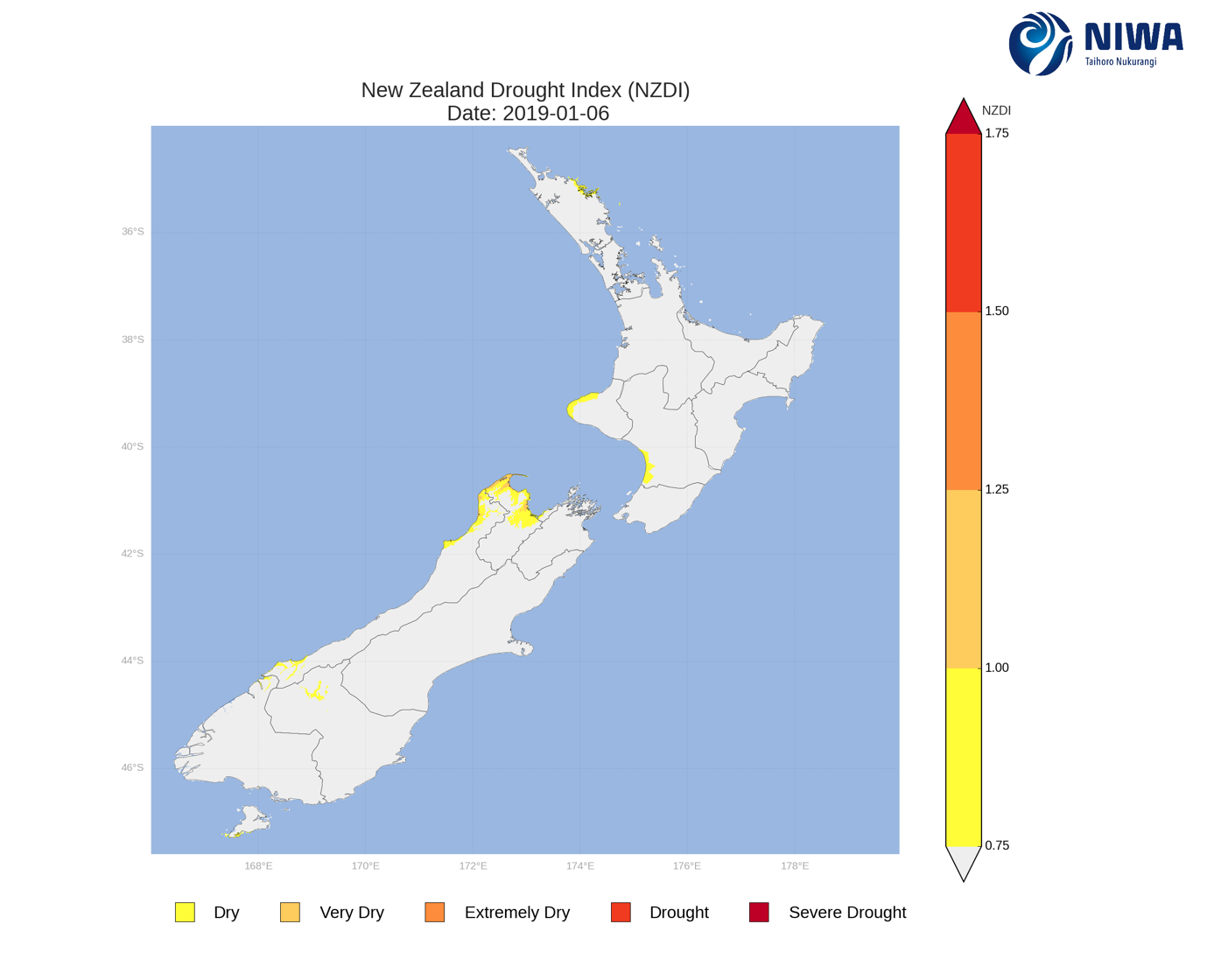NIWA's Hotspot Watch 10/1/19
Wednesday, 9 January 2019
NIWA's Hotspot Watch
A weekly update describing soil moisture across the country to help assess whether severely to extremely dry conditions are occurring or imminent. Regions experiencing these soil moisture deficits are deemed “hotspots”. Persistent hotspot regions have the potential to develop into drought.
Facts: Soil Moisture
Across the North Island, soil moisture levels decreased during the first week of 2019 due to meagre rainfall caused by high pressure sitting nearby. The driest soils in the North Island compared to normal are currently found in the eastern Far North District, around New Plymouth, and coastal Horowhenua. The wettest soils are found in Gisborne and coastal Wairarapa. Current small hotspots are located in coastal Kapiti Coast and Horowhenua, along with the eastern Far North District.
Across the South Island, soil moisture levels generally increased in Southland and the lower West Coast and remained constant or slightly decreased elsewhere. The driest soils across the South Island compared to normal for the time of year are found in the western Tasman Region, along with the western Buller District. The wettest soils are located in coastal Otago and around Kaikoura. Current hotspots are located in Nelson and nearby portions of Tasman.


Pictured above: Soil Moisture Anomaly Maps, relative to this time of year. The maps show soil moisture anomaly for the past two weeks.
Outlook and Soil Moisture
In the North Island, rainfall is likely to be fairly light through Sunday (13th January) with high pressure in control. An approaching low from the southwest may bring moderate rainfall to the south and central North Island starting Monday (14th January) through mid-week; however, forecast confidence at this point is relatively low. The highest rain totals in the upcoming week will likely be found in the eastern North Island, where totals may exceed 25 mm. Thus, eastern areas may experience slight increases in soil moisture, but soil moisture levels will likely decrease in the upper and western North Island. Due to the anticipated low rainfall in the north, the hotspot in the Far North may grow in the upcoming week, while the hotspot in coastal Kapiti Coast and Horowhenua may remain fairly constant.
In the South Island, a front will move up the west coast on Wednesday and Thursday (9th-10th January), resulting in moderate rainfall in the west. Isolated rainfall amounts exceeding 50 mm are possible in the West Coast and Fiordland high terrain, while lower elevations may see localised rainfall amounts over 30 mm. Rainfall is expected to be fairly sparse for the South Island on Friday and Saturday (11th-12th January). Thereafter, low pressure may bring additional rainfall to the island on Monday (14th January). The highest rain totals in the upcoming week will likely be along the West Coast, while areas east of the Alps may see rainfall totals generally less than 10-20 mm. Soil moisture levels will likely increase in the west but decrease in Canterbury and Otago. With the anticipated rain, the current hotspot around Nelson may remain constant or strengthen slightly.

The New Zealand Drought Index (NZDI) map below shows continuing dry areas across small parts of the North Island along with upper and western South Island as of 6 January. Please note: the soil moisture anomaly map may not correspond with the NZDI map, mainly because the NZDI uses additional dryness indices including one which integrates the rainfall deficit over the past 60 days. Changes are therefore slower to appear in the NZDI compared to the instantaneous status maps of soil moisture anomaly.
Background:
Hotspot Watch a weekly advisory service for New Zealand media. It provides soil moisture and precipitation measurements around the country to help assess whether extremely dry conditions are imminent.
Soil moisture deficit: the amount of water needed to bring the soil moisture content back to field capacity, which is the maximum amount of water the soil can hold.
Soil moisture anomaly: the difference between the historical normal soil moisture deficit (or surplus) for a given time of year and actual soil moisture deficits.
Definitions: “Extremely” and “severely” dry soils are based on a combination of the current soil moisture status and the difference from normal soil moisture (see soil moisture maps at https://www.niwa.co.nz/climate/nz-drought-monitor/droughtindicatormaps)


 BusinessNZ Energy Council: Forging International Partnerships In Energy
BusinessNZ Energy Council: Forging International Partnerships In Energy Hugh Grant: Empowering Financial Insights With A News API
Hugh Grant: Empowering Financial Insights With A News API Nathan Cooper, The Conversation: Unambitious And Undermined - Why NZ’s Latest Climate Pledge Lacks The Crucial ‘Good Faith’ Factor
Nathan Cooper, The Conversation: Unambitious And Undermined - Why NZ’s Latest Climate Pledge Lacks The Crucial ‘Good Faith’ Factor KiwiRail: Remutaka Tunnel Renewal Complete, Trains Back In Service Monday Morning
KiwiRail: Remutaka Tunnel Renewal Complete, Trains Back In Service Monday Morning Cawthron Institute: Independent Science Could Break Stalemates In Global Plastics Treaty Negotiations
Cawthron Institute: Independent Science Could Break Stalemates In Global Plastics Treaty Negotiations KiwiRail: Great Journeys New Zealand Brings The ‘WOW’ Factor With VIP Packages
KiwiRail: Great Journeys New Zealand Brings The ‘WOW’ Factor With VIP Packages



